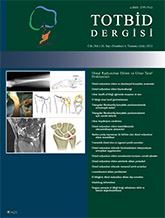
Distal radioulnar joint (DRUJ) moves synchronously with proximal radioulnar joint and should be considered as a part of bicondylar forearm joint. DRUJ is formed by sigmoid notch of radius and convex articular surface of ulnar head. Radius swings around immobile ulnar head during pronation and supination, which comprises rotation and translation of distal radius. Position of hand at space can be adjusted with these motions and grabbing of an object can be achieved with minimum energy consume. Stability provides pain-free transfer of loads from the wrist to the elbow, and allows harmonious pronation and supination. Bone congruency, integrity of ligaments, dynamic compression of muscles, interosseous membrane, joint capsule, and proprioception are elements of stability. Bone congruency and integrity of ligaments are the primary elements. Joint surfaces are not perfectly congruent and allows some translational motion of the distal radius. Translation of the distal radius becomes more evident with the extremes of pronation and supination, thus, further stability is provided with soft tissues. The primary soft tissue structures responsible for static stability are the dorsal and volar radioulnar ligaments of triangular fibrocartilage complex (TFCC). Additionally, the ulnolunate ligament of TFCC is important for DRUJ stability, however, ulnotriquetral ligament along with joint disc and meniscus homologue are important for shock absorption. Pronator quadratus and extensor carpi ulnaris muscles compress DRUJ and act as dynamic stabilizers. Mechanoreceptors, which are abundant in radioulnar ligaments, are considered to have important proprioceptive function for stability. Mobility and stability of DRUJ are dependent on integrity and harmony of static components and dynamic actions of neuromuscular structures. Therefore, structures that provide DRUJ mobility and stability must be preserved and anatomically restored when injured.